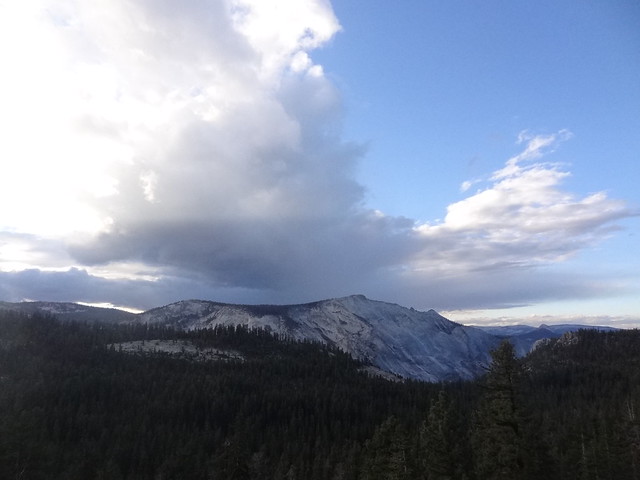Saddlebag campground is my favourite place as fall approaches. Cold night temperatures drive away the crowds, but perfect weather during the day opens up splendid Tuolumne Meadows alpine objectives. Last year I traversed North Peak and Conness and this year I had already done a car-to-car of Matterhorn. When the Sierra Mountaineering Club scheduled an early October trip I wanted to use the opportunity to climb Cathedral. I’ve been eyeing it for 2 seasons and felt ready.
I had a week off between jobs and after moving to a new apartment, I started the drive to Saddlebag Lake from San Francisco on a Thursday afternoon. Crossing the Bay Bridge and Altamont pass with no traffic was unusual. To augment my sparse rack I bought 2 small cams on the way.
There was a storm forecast for Thursday and Sunday and we were hoping to squeeze two days of climbing in between. Sure enough it started to pour as I passed Crane Flat. After nearly hitting a deer, I limped up Saddlebag Lake Road in low visibility, freezing temperatures and snowfall. Fortunately a few others had been at camp for a few hours and found a dead tree. This was burning happily and I just stood next to the fire until I mustered the will power to set up my tarp. The storm died out by 9pm to clear skies and a bright moon.
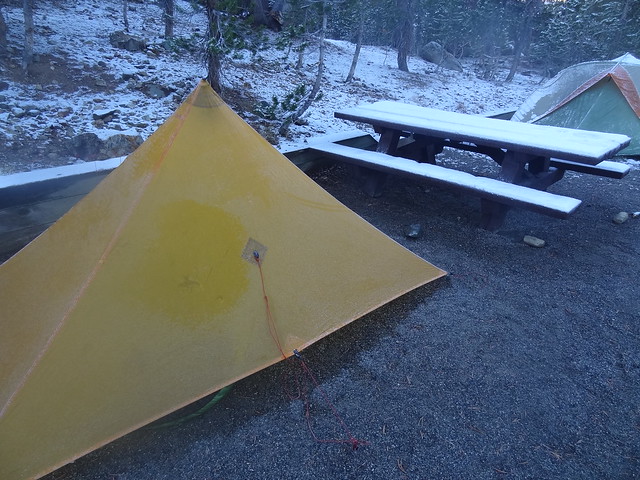
Technical alpine climbing the next day could be a hit and miss situation due to remnant snow (spoiled California climbers that we are!), but a moderate south/east face seemed reasonable. Seven of us headed to Unicorn Peak the next morning. After leaving the car at the Lembert Dome Parking lot around 9:40am, we hiked in to Tuolumne Meadows campground and found the trail to Elizabeth Lake.
What I love about Tuolumne is not having to deal with Eastern Sierra talus to climb great granite.
The trail goes around the north side of Elizabeth lake. An obvious talus gully is visible from the trail. Slabs lead north from about fifty feet above the gully. We made several class 3 moves to take the shortest approach, but I’m sure a class 2 approach exists if you head more towards the saddle than Unicorn.

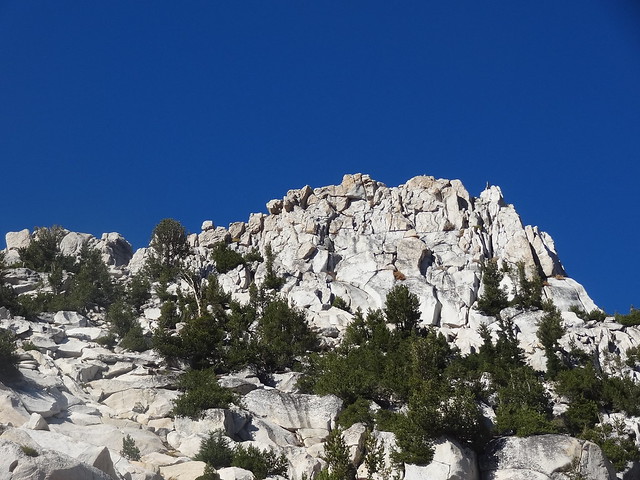
Head for the base of the notch between the middle and north summits. From there the route drops west, crossing a block with a roof that requires some exposed moves. A narrow fifteen foot section leads to a wider ledge. Next up is the crux of the climb. There is a six foot boulder that requires straddling a two feet gap to reach. There are a couple of good holds at the top, but if you are short it can be scary to reach up to find it. Farther along the route is a slung anchor that one climber could use to set up a rope for others.
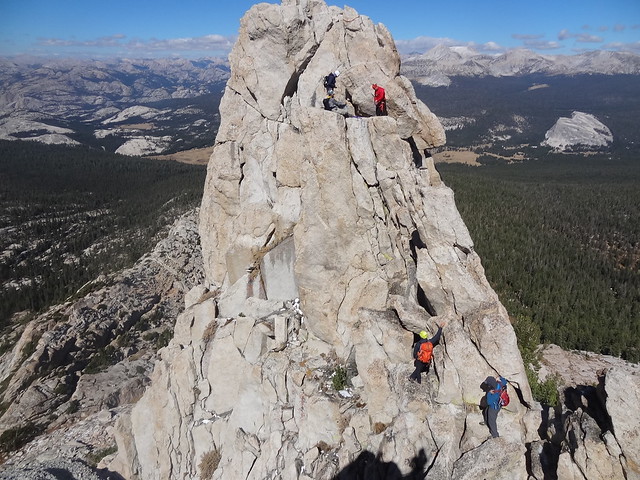
5 of us soloed the route (after considerable deliberation in my case) and brought up the other two on the rope. After the move, it is straight forward class 3 to the broad summit. We couldn’t find any register, but spent about 30 minutes hanging out in the great weather.
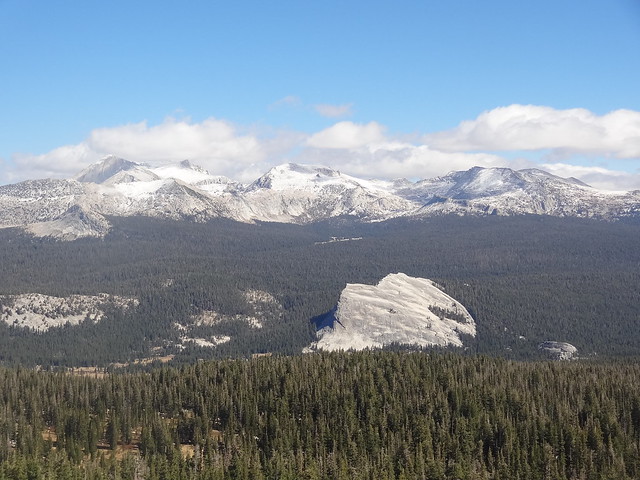
Unicorn is at the tail end of the Cathedral Range and Cockscomb, Matthes Crest, Echo Peaks and the namesake Cathedral Peak form a great arc across the sky. It is also an excellent vantage point to study the Southeast Buttress of Cathedral.
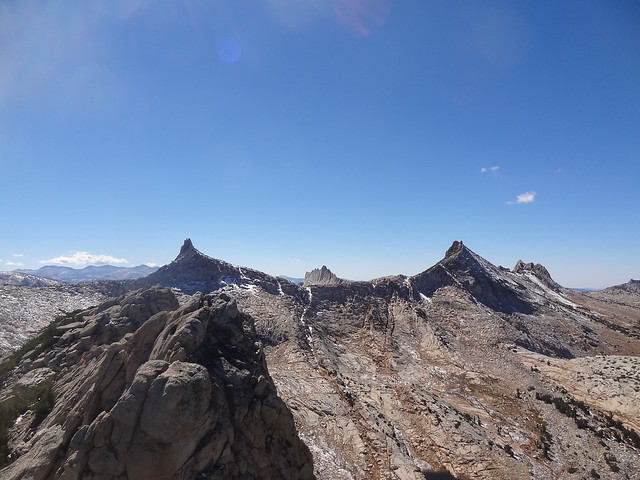
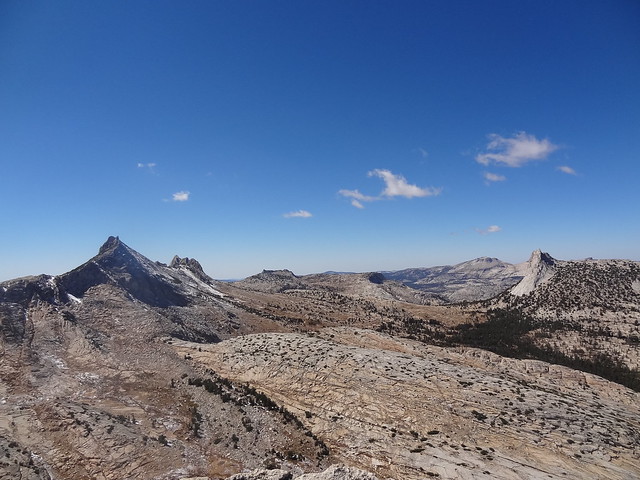
The descent reverses the route. You will need some brave soul to downclimb the boulder first (Nate in our case) and spot the others. I managed to rip my down jacket on this move.
Since we had plenty of time, we traversed south along the ridge towards the saddle. Reaching the middle summit requires going around the notch, but the rest of the traverse is class 3-4 on solid rock.
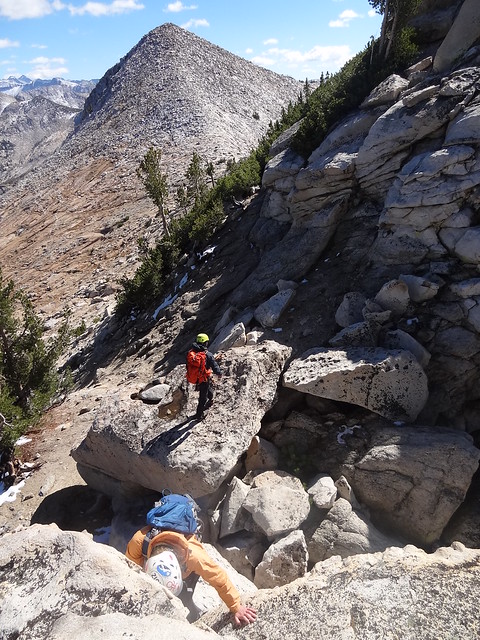
From here it was back to camp for a roaring fire and warm meals. Based on the beta and looking at Cathedral today, I felt reasonably sure I could lead the entire route, so Annie and I signed up to be the fifth team from our group to attempt the climb the next day!
We had a fairly small rack, but it would have to do.
- C4s 0.3, doubles of 0.5-3 (only one of #2)
- One 0.3 X4
- One set of nuts
- 4 quickdraws
- 4 double, 7 single slings
- 1 240cm sling - I love this thing, incredibly thin and versatile.
- 1 cordelette
- and the usual assortment of carabiners.
We carried a 70m rope but would have to pitch out more due to lack of protection.
Waking up early in freezing temperatures always sucks, but if you have everything packed the night before, it is easy to just change within the sleeping bag, shuffle out, throw the stuff in the car and wait while the engine warms the windows and your fingers.
We reached the trailhead by 6am and there was already another team heading out. We packed up some odds and ends, crammed food into our stomachs and headed out into the gathering dawn at 6:40.
The Supertopo description is quite accurate and we found the climber’s trail without issue. There were 4 parties already ready to climb when we reached the base of the A variation at 8am, but nobody on the B or C variation. More parties were coming in fast. After studying the topo we decided it was prudent to start on the B variation and join the “proper” route at the chimney. Even if we didn’t climb fast, at least we would avoid much of the crowds on the lower mountain. I put my hands on the rock at about 8:30.
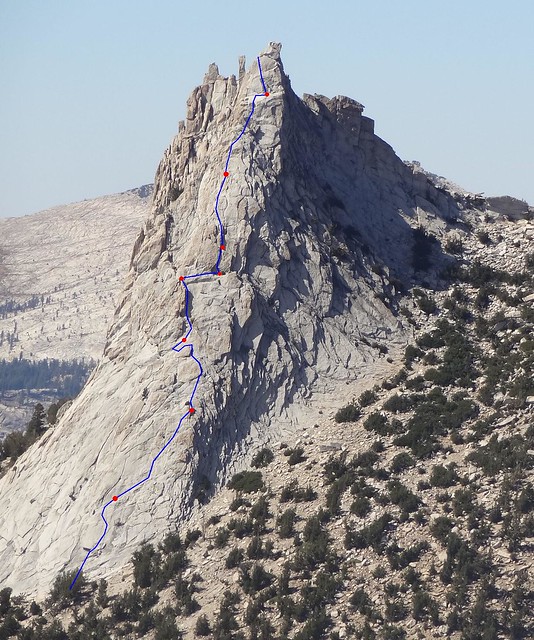
The first pitch starts on slab to a thin crack. Although the route seems to suggest going left of the bulge, I moved on to the face and followed a thin crack to the right, where I found a spectacular nut placement that I sorely needed at that point. Some spicy (for my abilities) climbing led to a nice ledge formed by the bulge. Pitch 2 requires some tricky moves to escape the crack system and move onto the knobby face, after which is is straightforward climbing to the tree belay. I had to do a hanging belay as the tree was taken.
One of the options on the next pitch is a traverse to the left that joins up with the A variation. This was the only legitimately scary moment on the route since the traverse involves descending a 2 inch wide platform with the possibility of pendulum (with only a small cam for protection), before a tricky face move to nicer ground. I was experiencing a lot of rope drag due to insufficient extension, which is why the annotated image shows an intermediate pitch far left of the chimney.
Annie led the traverse across the ledge to the chimney, then we waited for the 2 teams in front of us to clear it. This was my first real chimney climb on trad and I put in a lot of pro to compensate, but a great arm crack opens up just a few feet in allowing for very secure rest stances the entire way. After escaping the chimney, I lowered a bunch of rope down to Annie to haul up both our packs, then belayed her so I could get more gear for the next part of the route.
The rest of the route is fairly uneventful, with easy, but sometimes run out climbing and there really are a multitude of possibilities. These possibilities meant that by the time we were at the ledge below the summit pitch there were 4 ropes criss-crossing each other. The popularity of Cathedral does bring up a lot of safety issues and I think it is only the ease of the route and the mostly solid rock that has kept some horrible accident from happening. The next time I’d prefer to camp closer and start really early to avoid this risk.
The rest of our climb was punctuated by a certain urgency due to sinister clouds building up all across Yosemite (although they seemed to leave Cathedral alone) and I was quite impatient with Annie at one point, but she was trying to retrieve a cam! We reached the summit area around 4pm.
The summit was captured by several teams, not all of whom were willing to move quick, so we veered left instead. The summit was easy climbing but not worth the risk of a descent in the dark or being stranded in potentially bad weather.


A quick belay brought us to the small notch below the summit, from where class 4 terrain leads to the saddle between Eichorn Pinnacle and Cathedral. We rapped two rope lengths on the face, but then made some route-finding “errors” that put us on a descent to the Cathedral Lakes instead of descending back to the base of the route. I still don’t know where we should have turned sharply right. This class 4 descent cost us time, so that by the time we reached the John Muir Trail it was 6:30pm. An “enterprising” team was still trying to climb Eichorn while we were descending. More surprisingly we encountered a pet dog! I have no idea who it belongs to, but it was out there on hard terrain.
Once we were on the trail we took a break to eat the calories our bodies badly needed. I still haven’t figured out how to get myself to eat more at belays. After that it was an uneventful but occasionally toe-stubbing trip to the car. We finished at 8pm.
Rob and Art had bailed at the roof escape and gone to Echo Peaks instead. Sapth and Bobby had bailed before the chimney. Ignacio and Nate made it to the summit a little after us and made it down safely. Brian and Jen had a more involved descent in the dark. Seth and Haley, who were right before us, and whose last belay anchor we re-used had also made it down.
The awesome people at the campsite had hot water, a fire and lots of food (including pie!) already ready, which was really appreciated.
Cathedral was a truly impressive climb and raised my confidence and abilities on trad up a notch. To bag two great peaks, without any talus hopping is also a rare event in the Sierra :) A great way to end the summer.
The heavens had spared us that day, but opened up around 3am and dropped more rain at Saddlebag. When it stopped raining around 6:30am on Sunday, I quickly packed up and drove to breakfast in the low-lands!
